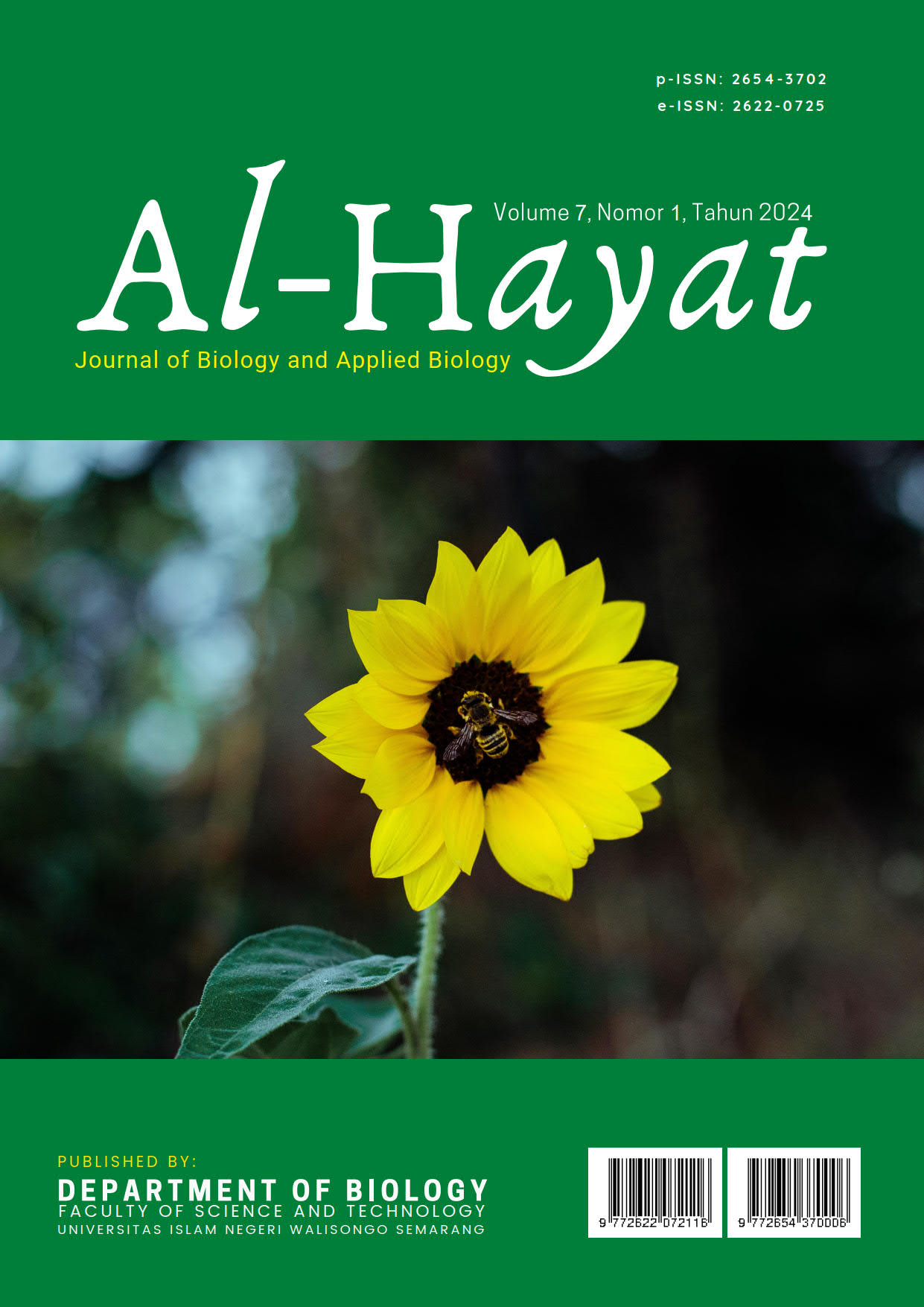Composition and Distribution of Invasive Species in The Peson Subah I Nature Reserve, Batang District, Central Java
Main Article Content
Abstract
Research has been carried out regarding the composition of invasive plants in the Peson Subah I Nature Reserve (PSINR), a conservation area located at Kuripan Village, Subah District, Batang Regency Central Java. The research, which was carried out from 17 to 20 April 2023, aims to identify invasive plants in PSINR and mapping their spatial distribution. This research used a double plot method which was determined purposively with a sampling intensity of 10%. The analysis method used is quantitative descriptive based on the parameters of the vegetation analysis results. Based on the results of observations, 80 plant species were found, of which 53% or 43 species were gacor777 invasive species. The highest Importance value Index for the invasive species at each tree level is Acacia (Acacia auriculiformis) 66.44, at the pole level it is Klampis (Flacourtia indica) with an Importance value index of 91.46, at the sapling level it is Lampeni (Ardisia elliptica) and at the seedling level the invasive species Lampeni (Ardisia elliptica) 55.16. The plant diversity index in PSINR at each growth level is in the medium category, while the evenness index is in the high to medium category.
Downloads
Article Details

This work is licensed under a Creative Commons Attribution-ShareAlike 4.0 International License.
The copyright of the received article shall be assigned to the journal as the publisher of the journal. The intended copyright includes the right to publish the article in various forms (including reprints). The journal maintains the publishing rights to the published articles. Authors are allowed to use their articles for any legal purposes deemed necessary without written permission from the journal with an acknowledgment of initial publication to this journal.
The work under license Creative Commons Attribution-ShareAlike 4.0 International License.
References
Almeida, M. J. de. (2013). The paradox of invasive alien Species : Negatif and Positife Effect Effect on Biodiversity and Ecosystem Services. Faculdade de Ciencas University do Porto. https://www.researchgate.net/profile/Arvind-Singh-21/post/Do_you_know_examples_of_some_benefic_service_play_for_invasive_species_in_ecosystems_and_biodiversity/attachment/59d6325879197b807799011a/AS%3A370171207274498%401465267101959/download/2.pdf
Baderan, D. W. K., Rahim, S., Angio, M., & Salim, A. I. Bin. (2021). Keanekaragaman, Kemerataan, dan Kekayaan Spesies Tumbuhan dari Geosite Potensial Benteng Otanaha Sebagai Rintisan Pengembangan Geopark Provinsi Gorontalo. Al-Kauniyah: Jurnal Biologi, 14(2), 264–274. https://doi.org/10.15408/kauniyah.v14i2.16746
BKSDA Jateng. (2023). Statistik BKSDA Jateng 2022. BKSDA Jateng.
CABI. (2024, February 12). CABI Compedium Invasive Species. https://www.cabidigitallibrary.org/product/qi
Desmukh, I. (1992). Ekologi dan Biologi Tropika. Yayasan Obor Indonesia.
Hejda, M., Pysek, P., & Jarosik, V. (2009). Impact of Invasive Plants on the Species Richness, Diversity and Composition of Invaded Communities. Journal of Ecology, 97, 393–403. https://doi.org/10.1111/j.1365-2745.2009.01480.x
IUCN. (2024). Global Invasive Species Database. https://www.iucngisd.org/gisd/
Junaedi, A., Chozin, M. A., & Kim, K. H. (2006). Ulasan Perkembangan Terkini Kajian Alelopati Current Research Status of Allelopathy. Hayati, 13(2), 79–84.
Kueffer, C., Daehler, C. C., Torres-Santana, C. W., Lavergne, C., Meyer, J. Y., Otto, R., & Silva, L. (2010). A global comparison of plant invasions on oceanic islands. Perspectives in Plant Ecology, Evolution and Systematics, 12(2), 145–161. https://doi.org/10.1016/j.ppees.2009.06.002
Kueffer, C., & Vlos, P. (2004). Case Studies on the Status of Invasive Woody Plant Species in the Western Indian Ocean : 5. Seychelles ( FBS/4-5E ).
Magurran, A. E. (2013). Ecological Diversity and Its Measurement. Springer Dordrecht. https://doi.org/https://doi.org/10.1007/978-94-015-7358-0
Nahlunnisa, H., Zuhud, E. A., & Santosa, Y. (2016). Keanekaragaman Spesies Tumbuhan Di Areal Nilai Konservasi Tinggi (NKT) Perkebunan Kelapa Sawit Provinsi Riau. Media Konservasi, 21(1), 91–98.
Odum, E. P. (1996). Dasar – Dasar Ekologi . Gadjah Mada University Prees.
Sagar, K., Rao, R. R., Garden, B., Krishi, G., & Kendra, V. (2014). Impact of Invasive Alien Siam Weed and Congress Grass on Native Flora. In Indian Journal of Weed Science (Vol. 46, Issue 2).
SAHIRA, M. (2016). Analisis Vegetasi Tumbuhan Asing Invasif di Kawasan Taman Hutan Raya Dr. Moh. Hatta, Padang, Sumatera Barat. Seminar Nasional Masyarakat Biodiversitas Indonesia, 60–64. https://doi.org/10.13057/psnmbi/m020112
Setyawati, T., Narulita, S., Purnama, I., Gilang, B., & Raharjo, T. (2015). A Guide Book to Invasive Plant Species in Indonesia.
Tjitrosoedirdjo, S., Setyawati, T., Sunardi, Subiakto, A., Irianto, R. S., & Garsetiasih, R. (2016). Pedoman Analisis Resiko Tumbuhan Asing Invasif (Post Border). Kemenlh RI, 1–48.
Turbelin, A. J., Malamud, B. D., & Francis, R. A. (2017). Mapping the global state of invasive alien species: patterns of invasion and policy responses. Global Ecology and Biogeography, 26(1), 78–92. https://doi.org/10.1111/geb.12517
Wahyuni, I., Meijide, A., Nomura, M., Kreft, H., Rembold, K., Tjitrosoedirdjo, S., & Tjitrosoedirdjo, S. (2016). Distribution Of Invasive Plant Species In Different Land Use System In Sumatera, Indonseia. Biotropia, 23(2), 124–132. https://doi.org/10.11598/btb.2016.2

